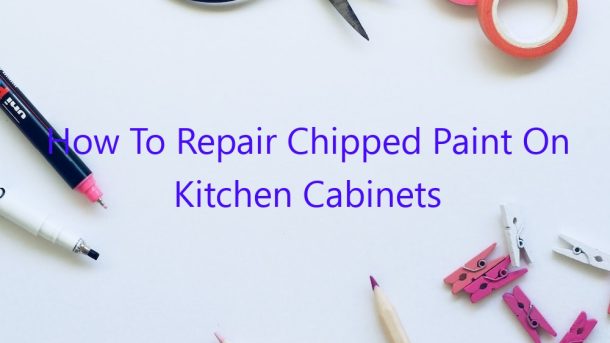If your kitchen cabinets are looking a little worse for wear, don’t worry – there is a way to fix them up and make them look as good as new. All you need is a little bit of paint and some basic tools. In this article, we will show you how to Repair Chipped Paint On Kitchen Cabinets.
The first step is to gather all of the necessary tools and supplies. These include:
-Paint
-Paintbrush
-Sandpaper
-Cotton swabs
-Rubbing alcohol
-Tape
-Paint primer
-Paint sealant
The next step is to sand down the chipped paint. Use a medium-grit sandpaper to do this, and be sure to sand in the direction of the wood grain.
Once the chipped paint has been sanded down, clean the surface with a cotton swab dipped in rubbing alcohol. This will remove any remaining dust or debris.
Now it’s time to apply the primer. Use a paintbrush to apply a thin coat of primer to the chipped area. Be sure to avoid painting over the surrounding paint, as this can cause the new paint to peel off.
Once the primer has dried, apply a coat of paint to the chipped area. Use a brush or a roller, depending on the size of the chip.
Finally, apply a coat of paint sealant to the entire cabinet. This will protect the paint from chipping and peeling.
And that’s it – your kitchen cabinets will now be looking as good as new.
Contents
How do you fix nicks in kitchen cabinets?
If you have nicks in your kitchen cabinets, don’t worry – you can fix them! All you need is some wood filler and a little bit of patience.
First, use a putty knife to fill in the nick with wood filler. Be sure to press the filler into the nick completely, and then use the knife to smooth it out.
Let the filler dry completely, then sand it down until it’s level with the surrounding wood.
Finally, paint over the area to seal it and camouflage the repair.
Why are my painted cabinets chipping?
Do you have beautiful painted cabinets in your home that you’ve spent a lot of time and money on? Are you noticing that they are starting to chip and peel? You’re not alone. A lot of people are experiencing this issue with their painted cabinets. So, what’s the reason behind this and what can you do to fix it?
There are a few reasons why your painted cabinets might be chipping and peeling. One reason could be that the paint isn’t adhering to the surface of the cabinet properly. This could be due to a number of reasons, such as the paint being of a lower quality or the surface of the cabinet not being properly prepared before painting. Another reason why your cabinets might be chipping is because of moisture. If your cabinets are in a moisture-rich environment, the paint can start to peel and chip.
If your cabinets are starting to chip and peel, there are a few things that you can do to fix the issue. One thing that you can do is to repaint the cabinets. Make sure that you use a high-quality paint and that the surface of the cabinet is properly prepared before painting. Another thing that you can do is to seal the surface of the cabinet with a sealant. This will help to protect the paint from moisture and will help to keep it from chipping and peeling.
How do you touch-up paint on wood cabinets?
When your wood cabinets start to look a little worse for wear, you might be tempted to just go ahead and repaint the entire thing. But before you break out the paintbrush, you might want to try touching up the paint instead. This can be a quick, easy, and affordable way to give your cabinets a new look.
The first step in touch-up painting is to identify the area that needs to be painted. Once you’ve determined the area, use a fine-pointed paintbrush to apply a thin layer of paint to the surface. Be sure to use the same type of paint that was originally used on the cabinet, and be careful not to overapply the paint.
If you’re not happy with the results, you can always try repainting the entire cabinet. But before you do, be sure to remove all of the hardware from the cabinet and cover the surrounding area with painter’s tape to protect it from paint splatters. Then, use a quality latex paint to give your cabinets a fresh new look.
How do you touch-up kitchen cabinets?
There are a few ways to touch up kitchen cabinets. The most common is to use a wood filler to fill in any scratches or dings. You can then use a wood stain or paint to match the color of your cabinets. Another option is to use a touch-up pen to fill in any scratches. These pens come in a variety of colors and can be used to match the color of your cabinets.
How do you touch up cabinet finishes?
Touching up cabinet finishes is a common task for many homeowners. It’s a quick and easy way to fix any small scratches or nicks that may have occurred over time. While there are many products on the market that can be used for this purpose, there are also a few simple steps that can be followed to achieve the best results.
The first step is to identify the type of finish that is on the cabinet. This can be done by checking the label or manufacturer’s website. Once the type of finish is identified, the appropriate touch-up product can be selected. There are many different types of touch-up products available, including pens, markers, and bottles with a brush or foam applicator.
The next step is to clean the area that needs to be touched up. This can be done using a clean cloth and a bit of rubbing alcohol or mineral spirits. Once the area is clean, the touch-up product can be applied.
For pens or markers, the tip should be allowed to touch the surface of the cabinet and then dragged along the scratch or nick. For bottles with a brush or foam applicator, the product should be dabbed into the scratch or nick and then spread out evenly.
It’s important to note that touch-up products should not be used to cover up large areas or entire cabinets. They should only be used to fix small scratches or nicks.
How do you fix paint nicks?
Paint nicks are a common occurrence, especially if you are someone who likes to do a lot of DIY projects. While it may be tempting to just leave them be, this can actually lead to even more damage in the future. By fixing paint nicks as soon as you notice them, you can prevent them from getting worse and save yourself a lot of time and hassle down the road.
The first step in fixing a paint nick is to clean the area around it. This can be done with a clean cloth and some rubbing alcohol or a solvent like paint thinner. Once the area is clean, you can begin to fix the nick.
There are a few different ways to do this, but the most common is to use a touch-up paint pen. These pens are available at most hardware stores and come in a variety of colors. To use them, simply shake them well and then press the tip against the nick. Apply pressure and move the pen in a circular motion until the nick is covered.
If you don’t have a touch-up pen, you can also use a brush or a toothpick to apply the paint. Just be sure to use a very small amount and to work in very small circles.
Once the paint is dry, you can then apply a clear coat over it to protect it from scratches and fading.
Can chipped paint be painted over?
Can chipped paint be painted over?
The answer to this question is yes, chipped paint can be painted over, but it is not always recommended. Before painting over chipped paint, it is important to determine if the underlying surface is damaged. If the surface is damaged, then it is likely that the new paint will also chip. If the surface is not damaged, then the new paint will likely adhere to the old paint.
If you decide to paint over chipped paint, it is important to use a primer. A primer will help the new paint adhere to the old paint and will also help to hide any imperfections. It is also important to use the correct type of primer for the type of paint you are using.
If you are using a latex paint, you should use a latex primer. If you are using a latex paint over a latex surface, you do not need to use a primer. If you are using an oil paint, you should use an oil primer.
It is also important to make sure that the surface is clean and free of dust and dirt before you start painting.



